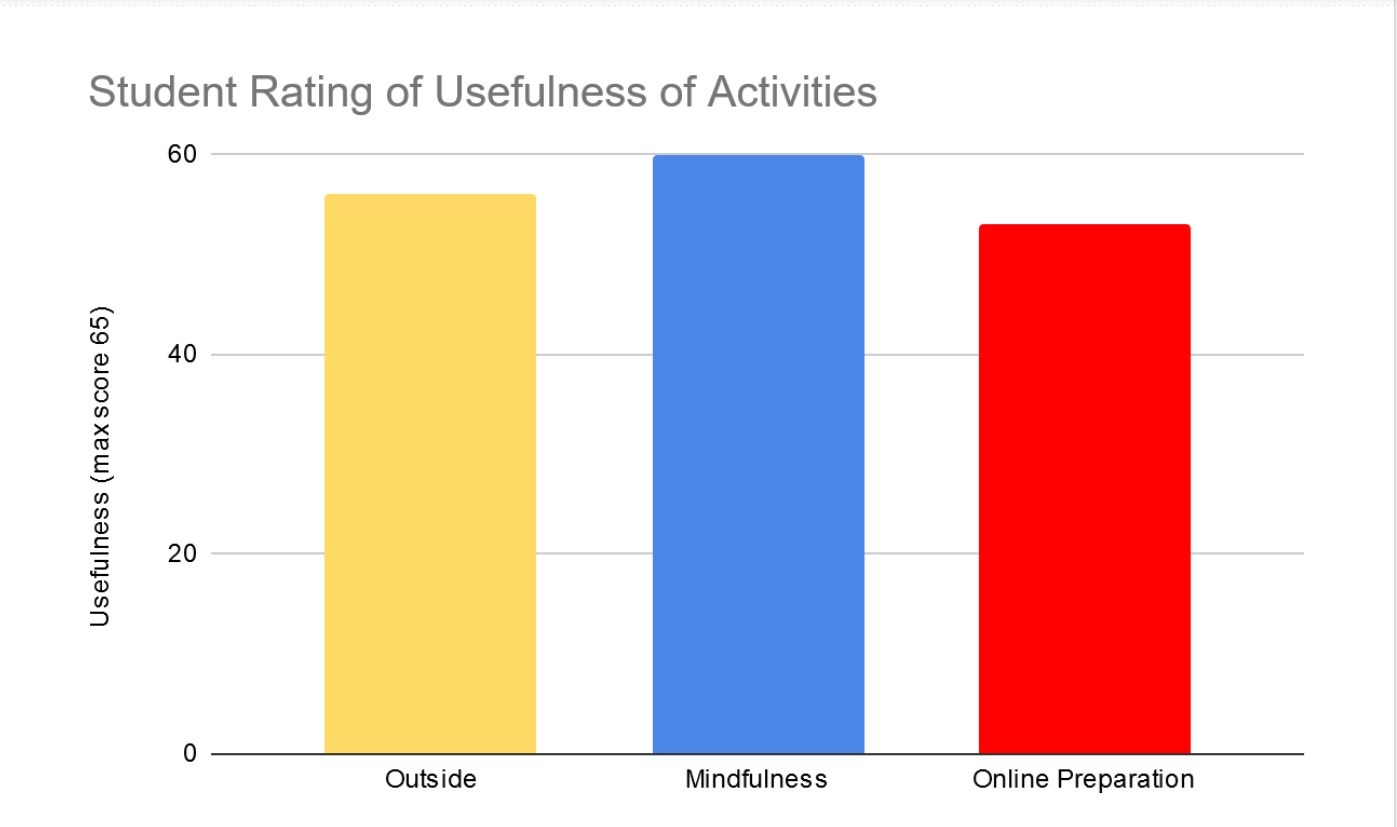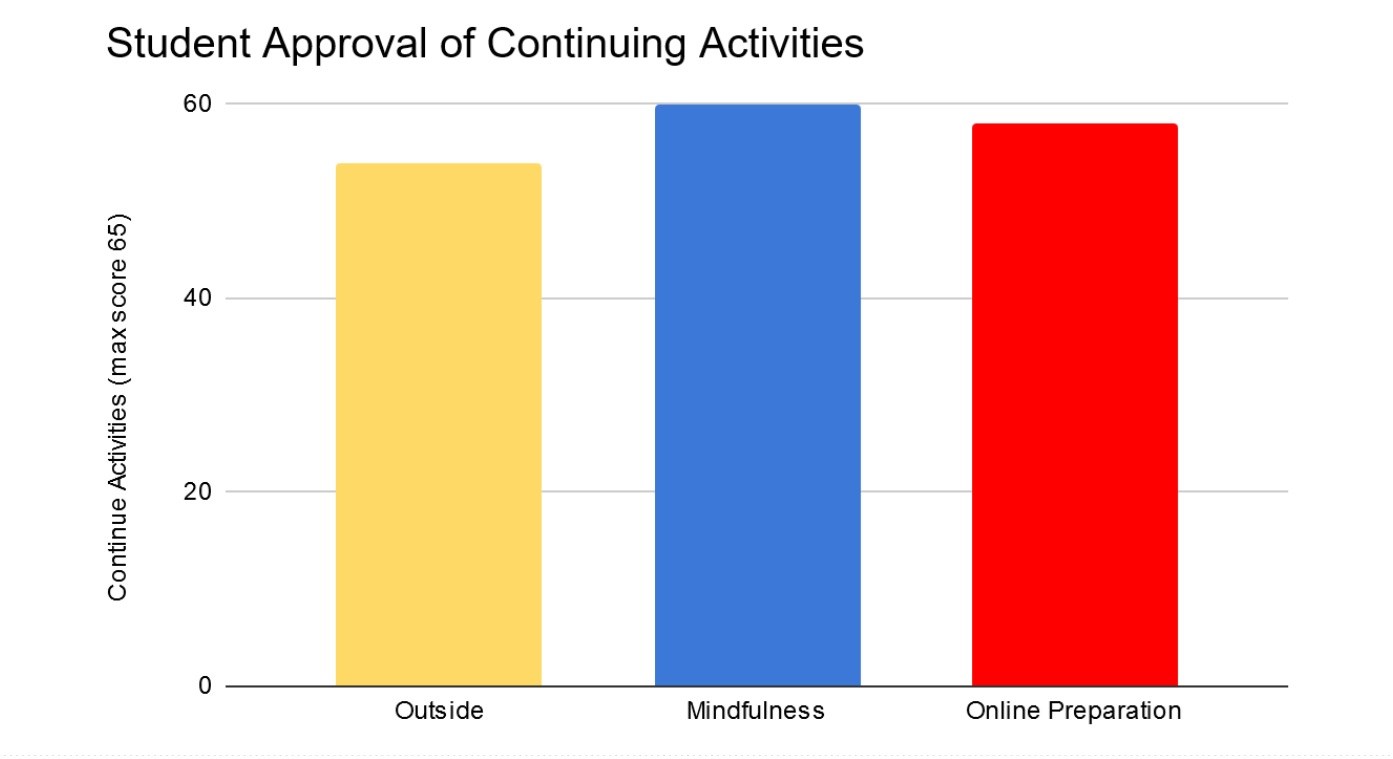
Research-Home
Context Focus Method
Findings Implications Gallery
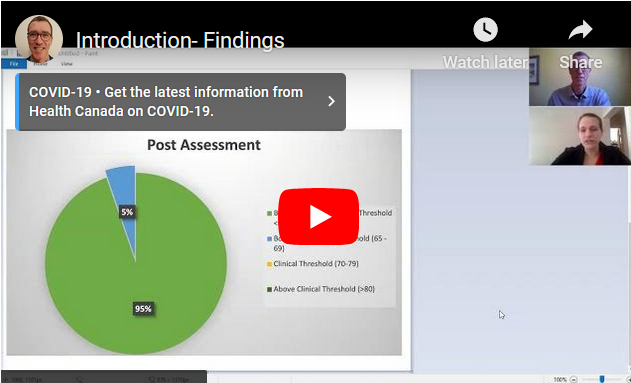
Surveys
Goal
The goal was to obtain a survey of the level of anxiety students were feeling at the beginning and end of the research project.
Categories
We have included how reports are ranked when using the RCADS scoring program: T-scores under 65 are considered Below Clinical Threshold. T-scores of 65 or higher indicate borderline clinical threshold. T-scores of 70 or higher indicate scores above clinical threshold. T scores above 80 only contain minor differences in percentile rankings and discriminations among such elevated T scores are not clinically meaningful (Chorpita et al. 2000).
The pre-assessment is based on 25 reports and the post-assessment consisted of 19 completed reports. The surveys completed at the start of the 2020-21 school year show that the majority of the class were not experiencing high levels of stress. 12% of the reports were at Borderline Clinical Threshold and 12% were considered Above Clinical Threshold. The post-survey was completed in the last week of the study and a significant decrease in anxiety levels is evident. There were no students reporting as Above Clinical Threshold and 5% considered Borderline Clinical Threshold.
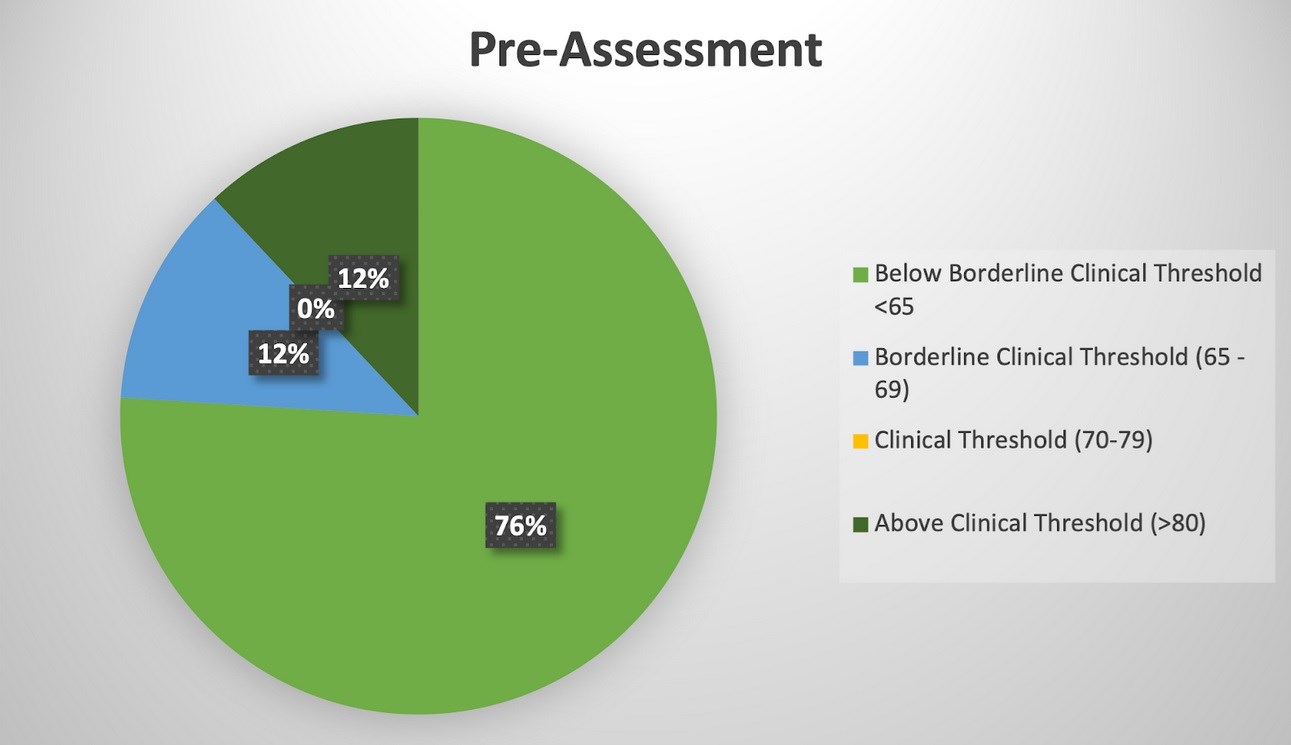
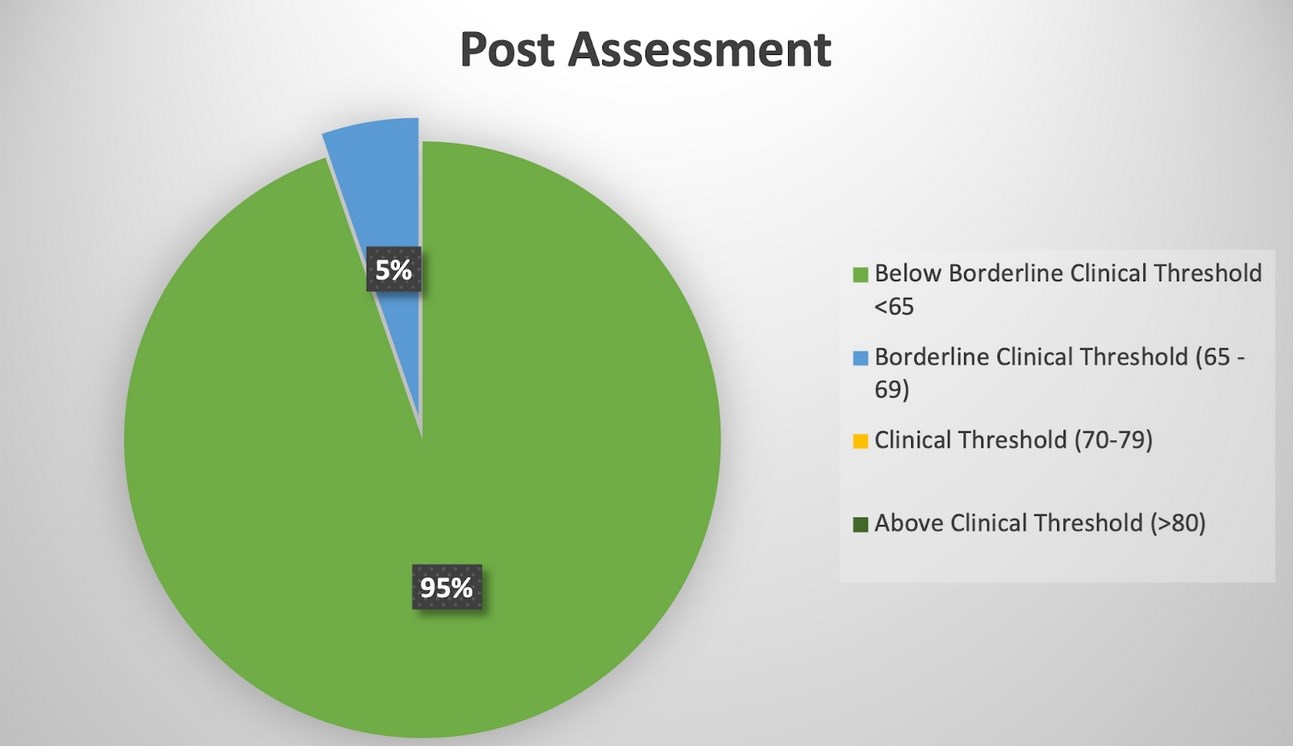
Journals
Journals proved useful means of gathering information from students. Journals provided a more open-ended way of gathering feedback than surveys. The information students shared about themselves was largely in agreement with the survey results and provided depth that surveys could not. They were limiting for students who, for a variety of reasons, lack the ability to write, or the ability to make a sustained effort at writing. Another limiting factor was attendance. Due to weather, fear of COVID-19, or family circumstance it was difficult to get a journal response from the entire class.
Students’ response to mindfulness, learning to work online, and learning outdoors were positive. Feedback about mindfulness was particularly useful. Students who responded to questions about mindfulness were generally positive. Typical entries read:
“I am grateful for having a way beter time at mindfulness and being more comer than yuhsawall.”
“Yes I would like to continue mindfulness. Mindfulness coms me down and the class and then it is easir to work.”
“Yes I like mindfulness because if I’m having a bad day I would like to use it.”
The notable exceptions to appreciating mindfulness as a regular part of the school day were some students who have difficulty with sustaining attention to tasks in the classroom. One of the students found an interesting way to compensate, his desk is by an aquarium in the classroom and he can focus on the fish during that time. Another student said, “Something I have been doing in class is mindfulness and i have not really bin enjoying it because it’s boring,” (student journal). In discussion with the student they observed that they were getting better at mindfulness and remained willing to take part in daily mindfulness practice.
Initially student journals were also intended to serve as gratitude journals. Students were given prompts to write about what they were grateful for in their lives. (quote research here). After three weeks it became apparent that the practice was not being used effectively and student interest was low. Students were already writing their journals and most showed a low degree of enthusiasm for additional writing. There was also some overlap between the gratitude journals and the Mindful Schools activities. The effort that went into the journal entries was, in general, low. Unless specifically prompted to add detail, the journal entries were generic. For example, “I’m grateful for my family,” (student journal) was one student’s repeated entry. Additionally, like any journal writing, students who struggle with writing struggled with the activity.
Observations
Observations were collected passively through observation and actively by asking students directly for their perceptions. Active perception checks were and are a regular part of classroom practice. Student discussions were regular. Students were invited to share their thoughts and feelings regularly after mindfulness practice in the morning. These discussions tended to be open ended and last only two to ten minutes. The practice of discussion dwindled as students became more acclimated to being at school and by the end of the project it was rare for students to sustain a discussion. Student discussion was also a part of health class as the students worked through the Mindful School booklet. Feedback was also gathered quickly using a ‘fist-to-five’ technique. Through a show of hands students can share their thoughts using a rating scale from low (a closed fist) to high (all five fingers held up). This is used regularly in the class to check perceptions and academic understanding. For example, after a lesson, students give a fist-to-five rating to their understanding to show if they can work independently, are not sure about their understanding, or need immediate help. Observations were recorded in a personal journal which fuelled weekly debriefing sessions between researchers.
On their initial return to school students were divided into two cohorts. Student responses to returning to school varied. On the first two days of school each group of students discussed how they felt about returning to school. A minority of students returned with a high degree of stress and anxiety, concerned about contracting COVID-19. A majority of students returned to school glad to see their classmates and to return to some sense of normalcy after six months away from school. Among the first cohort, “Two students were near tears talking about how they were feeling,” (personal observations Sept.8). The second cohort demonstrated less anxiety. “I found this group to be less anxious about the start of school, but there are still about a third of the students who say they are anxious about being back at school,” (personal observations Sept. 9). Both cohorts returned to school noticeably quiet. Students were observed talked quietly and talked less than a typical group of students returning to school. Reasons suggested for this were student anxiety or simply that they were “…out of practice being around other people,” (personal observation Sept. 9).
By the end of September mindfulness practice was showing tangible benefits. A student was injured on September 25, in a fall off a swing. The student fractured two fingers and dislocated a third. The fingers were iced and immobilized and the student was guided in mindfulness practice until someone arrived to take them to the hospital. The student was remarkably calm throughout. On October 4th another student was winded on the soccer field. When assistance was offered the student replied that they were alright and had practised mindful breathing after getting hurt. In October the school practised lock-down procedures. Students were aware that that the practice was going to be held. The class used the opportunity of the lock down to practice mindfulness. The lock down was successful. Students, with almost no exception, were calm and quiet for an extended period. No class from previous years has demonstrated this level of self-regulation.
Students’ familiarity with distance learning technology was initially low. Northwest School Division uses Microsoft Teams to deliver content for elementary students. According to information provided by students fewer than one quarter of them did any online work during the school closure in the spring. The majority of the remaining students did paper and pencil work and a small number of students did no schoolwork once the school was shut down. On October 9, the class made their first attempt at using Teams to work on an assignment. Of the 20 students present that day three students were able to log on to Teams and complete the assignment with minimal assistance. Two students were not able to log on to Teams even with assistance. Twelve students were eventually able to log on and complete the assignment. It was a frustrating exercise for most students. It did lead to the discovery of the chat feature of Teams. Students were excited to send and receive messages and it was a useful incentive for them to finish the assignment so they could take part.
Over the span of a week most of the technical problems were gradually reduced so all students were able to complete assignments using Teams. With students familiar with Teams the class was able to include students who were working from home. For one student who was out of the classroom for several weeks two students and one educational assistant worked online one period a day with them. Teams became a regular way to connect with other students in class and to work on some of the same work as the class was doing. The goal was to ease the student's return to the classroom by maintaining social connection and giving them confidence that they were continuing to learn what the rest of the class was learning.
At the end of the study period students were asked for feedback about working outdoors, mindfulness, and learning to work online. They were given opportunities for different kinds of feedback over the course of the last week of the project. In two class discussions at the end of the project students were asked to input for any changes they would like to see in the outdoor classroom, mindfulness, or practising online learning. Despite repeated prompts students offered no suggestions for changes and expressed overwhelming support for continuing the activities. During the same period, as a closing activity for the Mindful Schools program, students were asked to rate the activities and give their opinion about whether the activities should continue. The results were similar to the discussions. The results are shown in the graphs rating how useful the activities are and whether the activities should continue.
